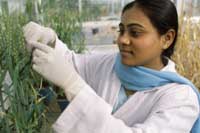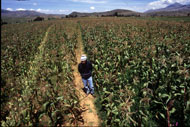



Context - We are regularly confronted with genetically modified foods, be it in the news or on our plates.
In what way are GM crops different from conventional crops?
What is known about their possible risks for human health or the environment?
Questions and answers have also been prepared by WHO with regard to the nature and safety of genetically modified food :
www.who.int/foodsafety/areas_work/food-technology/faq-genetically-modified-food/en/![]()
See also : Restrictions on Genetically Modified Organisms: United States :
www.loc.gov/law/help/restrictions-on-gmos/usa.php![]()
This Digest is a faithful summary of the leading scientific consensus report produced in 2004 by the Food & Agriculture Organization (FAO): "The State of Food and Agriculture
2003-2004![]()
1.1 Biotechnology refers to any technique that uses living organisms, or parts of these organisms. Such techniques are used to make or modify products for a practical purpose. Modern medicine, agriculture, and industry make use of biotechnology on a large scale. More...

1.2 Traditional biotechnologies such as the use of yeast to make bread or wine have been applied for thousands of years. Since the late 19th century, knowledge of the principles of heredity gave farmers new tools for breeding crops and animals. They selected individual organisms with beneficial characteristics and developed hybrid crops.
New methods have been developed since the discovery of the DNA structure in 1954. For instance, micro-organisms can be used to produce antibiotics, and the hereditary material in plants can be changed to make them resistant to pests or diseases. More...

2.1 Genes are the pieces of DNA code which regulate all biological processes in living organisms. The entire set of genetic information of an organism is present in every cell and is called the genome. More...
2.2 The genetic material is structured in a similar way in different species, which makes it easier to identify potentially useful genes. Certain species of crops, livestock, and disease-causing organisms have been studied as model species because they help us understand related organisms More...
2.3 Certain fragments of DNA that can be easily identified are used to ‘flag’ the position of a particular gene. They can be used to select individual plants or animals carrying beneficial genes and characteristics. Important traits such as fruit yield, wood quality, disease resistance, milk and meat production, or body fat can be traced this way. More...
2.4 Plants can be obtained from small plant samples grown in test tubes. This is a more sophisticated form of the conventional planting of cuttings from existing plants. Another laboratory technique, in vitro selection, involves growing plant cells under adverse conditions to select resistant cells before growing the full plant. More...
2.5 In conventional breeding half of an individual’s genes come from each parent, whereas in genetic engineering one or several specially selected genes are added to the genetic material. Moreover, conventional plant breeding can only combine closely related plants.
Genetic engineering permits the transfer of genes between organisms that are not normally able to cross breed. More...
2.6 For example a gene from a bacterium can be inserted into a plant cell to provide resistance to insects. Such a transfer produces organisms referred to as genetically modified (GM) or transgenic. More...
In conventional plant breeding, little attention has been paid to the possible impacts of new plant varieties on food safety or the environment. Nonetheless, this kind of breeding has sometimes caused negative effects on human health. For instance, a cultivated crop variety created by conventional cross breeding can contain excessive levels of naturally occurring toxins.
The introduction of genetically modified plants has raised some concerns that gene transfer could occur in the field between cultivated and wild plants and such concerns also apply to conventional crops. Such transfers have occasionally been reported but are generally not considered a problem. More...
4.1 Foodstuffs made of genetically modified crops that are currently available (mainly maize, soybean, and oilseed rape) have been judged safe to eat, and the methods used to test them have been deemed appropriate. These conclusions represent the consensus of the scientific evidence surveyed by the International Council for Science (ICSU) and are consistent with the views of the World Health Organization (WHO).
However, the lack of evidence of negative effects does not mean that new genetically modified foods are without risk. The possibility of long-term effects from genetically modified plants cannot be excluded and must be examined on a case-by-case basis. New techniques are being developed to address concerns, such as the possibility of the unintended transfer of antibiotic-resistance genes.
Genetic engineering of plants could also offer some direct and indirect health benefits to consumers, for instance by improving nutritional quality or reducing pesticide use. More...
4.2 Scientists recommend that food safety assessment should take place on a case-by-case basis before genetically modified food is brought to the market. In such assessments, foodstuffs derived from genetically modified plants are compared to their conventional counterparts, which are generally considered safe due to their long history of use. This comparison considers to what extent different foodstuffs can cause harmful effects or allergies and how much nutrients they contain. More...
4.3 Consumers may wish to select foods on the basis of how they are produced, because of religious, environmental, or health concerns. However, merely indicating whether a product is genetically modified or not, without providing any additional information, says nothing about its content nor about possible risks or benefits. International guidelines are being developed for labelling genetically modified foods. More...

5.1 Agriculture of any type has an impact on the environment. Genetic engineering may accelerate the damaging effects of agriculture, have the same impact as conventional agriculture, or contribute to more sustainable practices.
Growing genetically modified or conventional plants in the field has raised concern for the potential transfer of genes from cultivated species to their wild relatives. However, many food plants are not native to the areas in which they are grown. Locally, they may have no wild relatives to which genes could flow.
Moreover, if gene flow occurs, it is unlikely that the hybrid plants would thrive in the wild, because they would have characteristics that are advantageous in agricultural environments only. In the future, genetically modified plants may be equipped with mechanisms designed to prevent gene flow to other plants.
A controversy has arisen about whether certain genetically modified plants (which are insect resistant because they carry the Bt gene) could harm not only insect pests but also other species such as the monarch butterfly. In the field, no significant adverse effects on non-target species have so far been observed. Nonetheless, continued monitoring for such effects is needed. More...
5.2 Genetically modified crops may have indirect environmental effects as a result of changing agricultural or environmental practices. However, it remains controversial whether the net effect of these changes will be positive or negative for the environment. For example, the use of genetically modified insect-resistant Bt crops is reducing the volume and frequency of insecticide use on maize, cotton and soybean. Yet the extensive use of herbicide and insect resistant crops could result in the emergence of resistant weeds and insects. More...
5.3 The broad consensus is that the environmental effects of genetically modified plants should be evaluated using science-based assessment procedures, considering each crop individually in comparison to its conventional counterparts. More...
6.1 Animal feeds frequently contain genetically modified crops and enzymes derived from genetically modified micro-organisms. There is general agreement that both modified DNA and proteins are rapidly broken down in the digestive system.
To date no negative effects on animals have been reported. It is extremely unlikely that genes may transfer from plants to disease-causing bacteria through the food chain. Nevertheless, scientists advise that genes which determine resistance to antibiotics that are critical for treating humans should not be used in genetically modified plants. More...
6.2 As of 2004, no genetically modified animals were used in commercial agriculture anywhere in the world, but several livestock and aquatic species were being studied. Genetically modified animals could have positive environmental impacts, for example through greater disease resistance and lower antibiotic usage. However, some genetic modifications could lead to more intensive livestock production and thus increased pollution. More...
7.1 Certain barriers to international agricultural trade have been reduced by the World Trade Organization (WTO). A WTO agreement adopted in 1994 establishes that countries retain their right to ensure that the food, animal, and plant products they import are safe. At the same time it states that countries should not use unnecessarily stringent measures as disguised barriers to trade. More...
7.2 Several international agreements relate to the environmental aspects of genetically modified crops. The Convention on Biological Diversity is mainly concerned with the conservation and sustainable use of ecosystems but also with environmental effects of GMOs. A part of this convention is the Cartagena Protocol on Biosafety, which regulates the export and import of genetically modified crops.
The International Plant Protection Convention was adopted to prevent the spread of pests affecting plants and plant products. It identified potential pest risks related to GMOs that may need to be considered, such as the potential development of invasive species or effects on beneficial insects and birds. More...
8.1 Agricultural biotechnology can be seen as both:
Agricultural biotechnology has international implications and may become increasingly important for developing countries. 1 However, research has tended to focus on crops important to developed countries. More...
8.2 To date, countries where genetically modified crops have been introduced in fields, have reported no significant health damage or environmental harm. Moreover, farmers are using less pesticides or using less toxic ones, reducing harm to water supplies and workers' health, and allowing the return of beneficial insects to the fields. Some of the concerns related to gene flow and pest resistance have been addressed by new techniques of genetic engineering.
However, the lack of observed negative effects does not mean that they cannot occur. Scientists call for a cautious case-by-case assessment of each product or process prior to its release in order to address legitimate safety concerns.
“Science cannot declare any technology completely risk free. Genetically engineered crops can reduce some environmental risks associated with conventional agriculture, but will also introduce new challenges that must be addressed. Society will have to decide when and where genetic engineering is safe enough.” ( FAO 2004) More...

This summary is free and ad-free, as is all of our content. You can help us remain free and independant as well as to develop new ways to communicate science by becoming a Patron!